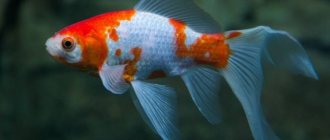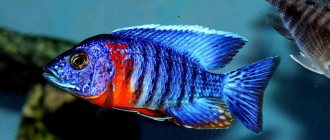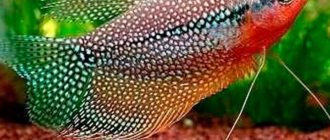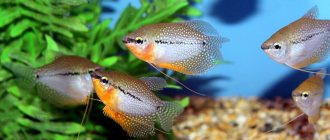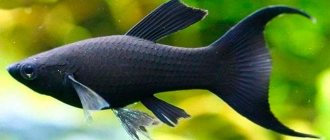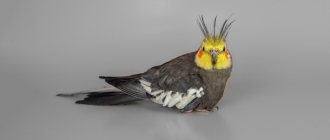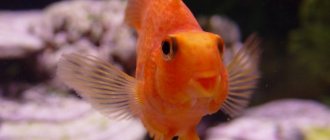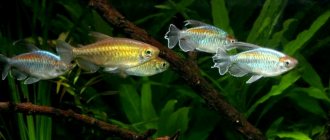Angelfish is a popular aquarium fish, a representative of the Cichlid family. Fish have long been loved by aquarists. These representatives of cichlids are even called angels in a number of countries. Their lightness, sophistication and delicacy of appearance captivate people immediately, and it is not uncommon for hobbyists to keep only a species aquarium with angelfish at home. These fish have been living in the home for 100 years, and during this time they have managed to transform from an exotic rarity into pets available to every lover. Pisces are unpretentious, which also increases their popularity. However, angelfish still cannot avoid diseases. They are distinguished by intelligence, and are able to bind the owner to themselves so much that he is worried about the question of how long angelfish live.
Lifespan
In the wild in the Amazon, angelfish can live between 20 and 25 years. The water in their habitat is warm and rich in oxygen. It is impossible to create conditions identical to natural ones in an aquarium. Even with the most competent care and a large container area, fish at home only live 10-12 years. There are isolated cases where they lived up to 20 years. Older fish require special care.
Keeping them in captivity robs angelfish of 10-15 years of life. The hybrid species bred today are not long-lived, and 10 years in an aquarium does not constitute a shortened life. They often die from pathologies, and therefore, if an elderly hybrid angelfish has a swollen belly, treatment will be ineffective. There is no point in looking for the reason why the pet died - she grew old.
How to distinguish a male Angelfish from a female
It is sometimes difficult to distinguish the sex of a given fish and is only possible when they become sexually mature - at 8-12 months. When buying young animals, you clearly cannot distinguish a male from a female, but the larger ones will probably turn out to be males.
The main distinguishing feature is that males have a fatty bump on their forehead, while female Angelfish do not. Also, in pairs, males are more active, but this is not a clear distinguishing feature, because sometimes females also imitate the behavior of the male.
What are the advantages of living in an aquarium?
The life of pets in an aquarium has its advantages, despite the shorter duration. The advantages of this content are:
- safety - the aquarium does not contain the predators that live in the Amazon. Few fry survive to adulthood under natural conditions. In an aquarium, the survival rate of broods is 90%;
- Regular high-quality nutrition - in nature, the nutrition of fish depends on their physical capabilities and weather conditions. In an aquarium, feeding is regular, complete and does not require energy expenditure, and also does not endanger the life of the angelfish due to predators;
- stability of water indicators - the softness of water in nature is stable, but the temperature regime is constantly changing. Such jumps are an additional load for the fish’s body, which negatively affects its condition. In the aquarium, the electronics maintain a smooth mode;
- safe spawning - in nature, only a few individuals grow from a brood, since the fry remain live food until they reach a significant size. In a home pond, maximum young animals survive.
Considering the benefits of keeping angelfish in aquariums, it cannot be said that it is cruel to them.
Breeding
Angelfish are relatively easy to raise in a home aquarium. Since there are no pronounced differences between young males and females, it is better to purchase a group of 3-6 fish and they will organize pairs themselves.
For breeding, a higher temperature is required, up to 28-30°, and some broad-leaved plants are required, for example, cryptocorynes, echinodorus, etc. The fish clean the leaf they have chosen from sand, silt, and food residues and the female lays one egg on it , arranging them in rows, and the male fertilizes each of them separately.
At the end of spawning, both fish remain near the eggs and fan them all the time with their fins to ensure an influx of fresh water. The male and female free the fry that have developed in the eggs from the egg shell and spit them out onto the leaves. Here the fry hang on short threads for the first time. Later, the parent fish transfer the fry to a flat hole they dug in the sand and keep there for 4-5 days.
After this, the fry make their first attempts at independent swimming. After another two days, the parents take the flock of fry out for a walk. At this time they need to be given the smallest live food. The fry very soon switch to relatively large food, such as small cyclops, so that there are not too many difficulties in obtaining food.
Some hobbyists prefer to transfer a plant leaf with eggs laid on it into a jar with the same water, but without soil and plants, placing it near an air spray. From laid eggs, of which there are up to 600 pieces. The fry are hatched, as a rule, in numbers equal to half or two-thirds of the number of eggs.
Disadvantages of aquarium life
The disadvantage of keeping fish in an aquarium is the lack of natural selection. In an artificial environment, thanks to comfortable conditions and care, weak aquarium angelfish, which would have died in childhood while living in the Amazon, also survive. They end up in breeding, which leads to a decrease in the quality of the angelfish genetic pool. As a result, aquarists keep hybrids based on real angelfish, which live longer than 6-8 years, since these decorative but weak individuals are susceptible to disease. When treating fish, the temperature of the water in the aquarium is increased to speed up metabolic processes in their body and better saturate the tissues with the necessary substances. However, accelerated metabolism shortens the life expectancy of pets, increasing the rate of wear and tear of organs and systems. The need to treat ornamental hybrids is one of the negative aspects of keeping angelfish in an aquarium.
Factors affecting fish life
Several factors, in addition to their health, influence the lifespan of angelfish in artificial conditions. Knowing what to do, you can extend the life of fish for as long as possible. For a high-quality and long life, angelfish must be provided with:
- the volume of the aquarium is 100 liters per fish - in a tighter reservoir, angelfish cannot develop normally and do not grow fully. Against the background of underdevelopment, internal organs fail within a short period of time after 2-4 years, and the fish dies. Intestinal problems, red eyes (not to be confused with red-eyed species) and lethargy are common, these are signs of a general disorder in the body;
- aeration – the fish’s need for oxygen is increased, so it is necessary to turn on the compressor in the aquarium for 30-40 minutes in the morning and evening. This improves the condition of pets and, by increasing immunity, prevents them from contracting bacterial infections. Treatment, if necessary, is faster and easier;
- cleaning the bottom - remove food residues, fish waste and rotting parts of plants once a week. When the aquarium is cloudy, the fish suffocate in it from poisoning by rotting products;
- water replacement - water should be replaced 1/4 times a week and 4/5 - 1 time every 3 months. The characteristics of fresh water must correspond to those remaining in the aquarium. When the water is different, angelfish experience severe stress, which is harmful to their health. It is not uncommon that if the change is incorrect, you can see that the angelfish’s eye has become cloudy;
- nutrition – it should be as close to natural as possible. Angelfish should be given bloodworms, coretra, daphnia, earthworms soaked in water, snails, and cyclops. Combined food and vegetable food are required: lettuce, woodlice, spinach, finely grated cucumber. Feed portions should be such that the fish eat them within 5-10 minutes. Any remaining food that has settled to the bottom is removed immediately. If fed incorrectly, the angelfish's intestines may protrude, the body may swell, and the belly may swell.
Neighbors for angelfish
A species aquarium for angelfish is the best option. If you want to have a pond with several species of fish, then you need to wisely choose neighbors for your pets. Fish that are too active will irritate the angelfish, and small ones will be swallowed at some point. The best neighbors for angelfish are:
- non-aggressive cichlid species;
- catfish of all types, except aggressive ones;
- red swordtails;
- gourami;
- apistograms;
- lalius;
- parrots
The proximity of angelfish to goldfish is undesirable: active ones can easily injure angelfish, and the slow angelfish themselves begin to chase and gnaw off their fins.
About diseases
Angelfish diseases are more common in fish at an age when their immunity weakens. To protect them, they must be protected from stress as much as possible and aerated for at least 3 hours a day. If an angelfish has a swollen belly, then at the initial stage an anti-edema remedy is used, but later it is difficult to help. With veil fins, fin rot is often observed in angelfish, the symptoms of which are clear. Without immediate treatment, the fish die. Hexamitosis of angelfish is also possible. To prevent disease, use hydrogen peroxide or methylene blue. Part of the answer to the question of how long an angelfish lives depends on the owner.
Angelfish is a popular aquarium fish, a representative of the Cichlid family. Fish have long been loved by aquarists. These representatives of cichlids are even called angels in a number of countries. Their lightness, sophistication and delicacy of appearance captivate people immediately, and it is not uncommon for hobbyists to keep only a species aquarium with angelfish at home. These fish have been living in the home for 100 years, and during this time they have managed to transform from an exotic rarity into pets available to every lover. Pisces are unpretentious, which also increases their popularity. However, angelfish still cannot avoid diseases. They are distinguished by intelligence, and are able to bind the owner to themselves so much that he is worried about the question of how long angelfish live.
How many years will angelfish live?
Angelfish is a popular aquarium fish, a representative of the Cichlid family. Natural habitat - freshwater bodies of South America (Amazon and its tributaries). There, the water is saturated with a large amount of dissolved oxygen, which allows it to adapt to different living conditions. She has a hardy organism, her body shape and diet allowed her to adapt to captivity, enduring some changes in water parameters. Aquarists who keep these fish often have a question: “How long do angelfish live?”
As a fish belonging to the Cichlid family, its lifespan at home can be more than ten years. With proper maintenance conditions: proper feeding, clean water, a spacious aquarium, careful care, the life of this beautiful pet can be significantly extended. Long-lived specimens were also found among angelfish.
Quickly navigate to the article
Lifespan
In the wild in the Amazon, angelfish can live between 20 and 25 years. The water in their habitat is warm and rich in oxygen. It is impossible to create conditions identical to natural ones in an aquarium. Even with the most competent care and a large container area, fish at home only live 10-12 years. There are isolated cases where they lived up to 20 years. Older fish require special care.
Keeping them in captivity robs angelfish of 10-15 years of life. The hybrid species bred today are not long-lived, and 10 years in an aquarium does not constitute a shortened life. They often die from pathologies, and therefore, if an elderly hybrid angelfish has a swollen belly, treatment will be ineffective. There is no point in looking for the reason why the pet died - she grew old.
What are the advantages of living in an aquarium?
The life of pets in an aquarium has its advantages, despite the shorter duration. The advantages of this content are:
- safety - the aquarium does not contain the predators that live in the Amazon. Few fry survive to adulthood under natural conditions. In an aquarium, the survival rate of broods is 90%;
- Regular high-quality nutrition - in nature, the nutrition of fish depends on their physical capabilities and weather conditions. In an aquarium, feeding is regular, complete and does not require energy expenditure, and also does not endanger the life of the angelfish due to predators;
- stability of water indicators - the softness of water in nature is stable, but the temperature regime is constantly changing. Such jumps are an additional load for the fish’s body, which negatively affects its condition. In the aquarium, the electronics maintain a smooth mode;
- safe spawning - in nature, only a few individuals grow from a brood, since the fry remain live food until they reach a significant size. In a home pond, maximum young animals survive.
Considering the benefits of keeping angelfish in aquariums, it cannot be said that it is cruel to them.
Basic rules for feeding
There are several main rules that you must remember:
- Angelfish eat quite a lot, so you need to know exactly their daily dose.
- If after feeding the fish begin to beg for more, you cannot succumb to their provocations. They can eat as much as they want. But this will have a detrimental effect on the condition of the entire organism.
- Under no circumstances should bloodworms be given in large quantities. It's better to replace it with something more harmless. The symptoms of overeating are difficult to miss: the intestines swell, and the anal bladder increases in size and becomes pink.
- Only proven food is suitable, preferably branded.
READ How old do cats grow?
How long do cats take to grow? If there are soft plants in the aquarium, then you can say goodbye to them. Angelfish just love to pull them out. To avoid this, you should add food that contains spirulina to your diet.
Disadvantages of aquarium life
The disadvantage of keeping fish in an aquarium is the lack of natural selection. In an artificial environment, thanks to comfortable conditions and care, weak aquarium angelfish, which would have died in childhood while living in the Amazon, also survive. They end up in breeding, which leads to a decrease in the quality of the angelfish genetic pool. As a result, aquarists keep hybrids based on real angelfish, which live longer than 6-8 years, since these decorative but weak individuals are susceptible to disease. When treating fish, the temperature of the water in the aquarium is increased to speed up metabolic processes in their body and better saturate the tissues with the necessary substances. However, accelerated metabolism shortens the life expectancy of pets, increasing the rate of wear and tear of organs and systems. The need to treat ornamental hybrids is one of the negative aspects of keeping angelfish in an aquarium.
Arrangement of the incubator
Like all cichlids, angelfish have some semblance of parental instinct. They jealously protect their offspring, although only for the first couple of days. Having finished spawning, the parents protect their eggs from other inhabitants of the aquarium, fan them with their fins, return the fallen ones to their place and absorb the white ones.
In other cases, producers take care of the babies until they feed on their own. However, this behavior is typical if spawning occurs in a hatchery. In a general aquarium, angelfish either lose interest in the eggs or begin to eat them 3-4 hours after the end of spawning and at nightfall.
In order not to risk future offspring, you should move the eggs to another aquarium immediately after mating is completed.
The incubator for it is prepared as follows:
- This requires a capacity of 5-10 liters. Half of it is filled with water from the aquarium where adult angelfish live. The remainder is distilled water.
- A heater and an air spray are placed in the incubator, after which a substrate with eggs is placed. It is necessary to ensure that the eggs are under the flow of water from the sprayer and that no air gets on them.
- The temperature in the aquarium should be 30°C.
You can also place duckweed in an aquarium with young animals. This will prevent mold from forming. Ciliates live in it, which in the future will become food for grown-up fry. There should always be light in the incubator - a night light is placed next to it at night, and in the morning the whitened eggs are removed with tweezers.
Factors affecting fish life
Several factors, in addition to their health, influence the lifespan of angelfish in artificial conditions. Knowing what to do, you can extend the life of fish for as long as possible. For a high-quality and long life, angelfish must be provided with:
- the volume of the aquarium is 100 liters per fish - in a tighter reservoir, angelfish cannot develop normally and do not grow fully. Against the background of underdevelopment, internal organs fail within a short period of time after 2-4 years, and the fish dies. Intestinal problems, red eyes (not to be confused with red-eyed species) and lethargy are common, these are signs of a general disorder in the body;
- aeration – the fish’s need for oxygen is increased, so it is necessary to turn on the compressor in the aquarium for 30-40 minutes in the morning and evening. This improves the condition of pets and, by increasing immunity, prevents them from contracting bacterial infections. Treatment, if necessary, is faster and easier;
- cleaning the bottom - remove food residues, fish waste and rotting parts of plants once a week. When the aquarium is cloudy, the fish suffocate in it from poisoning by rotting products;
- water replacement - water should be replaced 1/4 times a week and 4/5 - 1 time every 3 months. The characteristics of fresh water must correspond to those remaining in the aquarium. When the water is different, angelfish experience severe stress, which is harmful to their health. It is not uncommon that if the change is incorrect, you can see that the angelfish’s eye has become cloudy;
- nutrition – it should be as close to natural as possible. Angelfish should be given bloodworms, coretra, daphnia, earthworms soaked in water, snails, and cyclops. Combined food and vegetable food are required: lettuce, woodlice, spinach, finely grated cucumber. Feed portions should be such that the fish eat them within 5-10 minutes. Any remaining food that has settled to the bottom is removed immediately. If fed incorrectly, the angelfish's intestines may protrude, the body may swell, and the belly may swell.
How long can he live in captivity?
The Amazon River has a slightly acidic pH and mild hardness levels. Perhaps the most unusual aquatic organisms live there, distinguished by their unique appearance and special body structure. In warm tropical waters, angelfish can live 20-25 years. However, in an aquarium where space is limited and the diet is not as varied, their life expectancy is halved. An artificial environment, completely dependent on humans, does not always provide the fish with a balanced environment.
With proper care, regular cleaning of the reservoir, aeration, angelfish live 10 years or more. If she is provided with constant care, without ignoring all maintenance requirements, she will live an order of magnitude longer, even 20 years. It seems that 10 years is not such a long time for joy, I would like more. But this figure is considered respectable for a not very large aquarium fish.
Watch a video on how to best care for angelfish.
What to do to extend the life of fish
The lifespan of an angelfish in an aquarium can be 15-25 years, if a number of requirements are met. First, be sure to place these fish in a spacious tank with a volume of at least 100 liters per pair (female and male). Secondly, install a compressor and an aerator; the fish will only be delighted with the oxygen-saturated water. The compressor should be turned on for 20-30 minutes twice a day.
As for general cleaning of the aquarium, it does not need to be done too often. If you remove leftover food and rotten plants in a timely manner, then the water can be changed less often; some manage to leave the water crystal clear for more than six months. Otherwise, water replacement should occur at least 3 times a month. Be sure to clean the soil, wash the walls of the tank and the filter from accumulated dirt and green algae. Monitor the water temperature - the new water must meet all the parameters of the “old” one.
Do not forget that angelfish will live more years if they are fed in an aquarium no worse than what they feed in the wild. In the wild, they are omnivores: they feed on insect larvae and insects, zooplankton, and plants. Therefore, they can be fed all suitable food: artificial for cichlids, dry, frozen and live. Bloodworms and tubifex should not be given, since they do not live in slightly acidic water. You can notice how the fish forms brownish bubbles at the anus - these are the negative consequences of feeding with bloodworms and tubifex.
What ornamental angelfish eat: microworms, brine shrimp, earthworms, snails, coretra, daphnia, cyclops, lettuce and spinach. It is not recommended to feed meat from warm-blooded animals, which is rich in fat. Granular feed with spirulina can be an additional supplement. You need to feed in such portions that the fish eat the food in 2-5 minutes. Overfeeding is also harmful and shortens the life of the fish; food residues can oxidize the water, spoiling its quality.
See how to care for angelfish to prolong their life.
Diseases of angelfish
Due to metabolic disturbances, improper maintenance conditions, and poor hygiene, fish can become ill after living in the aquarium for a few years. With poor aeration, the fish experience difficulty breathing and stay near the surface of the water, gasping for air. The eyes become pale, the inside of the gills become covered with necrotic plaques. In this case, you can gradually increase aeration by adjusting the water temperature and oxygen supply.
If it seems to you that the angelfish in the aquarium is lethargic, swims slowly, or the anus on the body is inflamed, this is an alarming signal. Hexamitosis is a parasitic disease of the gastrointestinal tract. Untimely intervention with medications can lead to infection of other fish or death. You can treat with erythrocycline baths with trichopolum (50 grams and 10 grams, respectively, in proportions per liter of water).
Angelfish can develop fin rot, which is a consequence of infection with a rod-shaped bacterium. This is the result of highly contaminated water if it is rarely changed. White opacities appear on the body of the angelfish, and the eye corneas also turn pale. Later, the rays of the fins begin to peel off and fall off, and ulcers form. The consequences of such a disease can be fatal - the fish will not live many years if it becomes infected from time to time. Treatment of fin rot: take green malachite, hydrochloride and bacillin-5 (in proportions of 0.1 mg, 100 mg, 4000 units per liter of water, respectively). The solution is added to a tank of water. Be sure to treat the aquarium decorations and douse the plants with bacillin.
Dermatomycosis is a fungal disease that reduces the number of years of life of fish. Untimely treatment will lead to death. Symptoms: white plaque on the body. Later, the fungus can spread to internal organs. For treatment, it is necessary to use streptocide, bacillin-5, copper sulfate, potassium permanganate (in proportions of 1 gram, 4000 units, 0.5 grams, 0.05 grams, respectively). Timely disease prevention, quarantine and quality treatment prolong the life of pets.
Neighbors for angelfish
A species aquarium for angelfish is the best option. If you want to have a pond with several species of fish, then you need to wisely choose neighbors for your pets. Fish that are too active will irritate the angelfish, and small ones will be swallowed at some point. The best neighbors for angelfish are:
- non-aggressive cichlid species;
- catfish of all types, except aggressive ones;
- red swordtails;
- gourami;
- apistograms;
- lalius;
- parrots
The proximity of angelfish to goldfish is undesirable: active ones can easily injure angelfish, and the slow angelfish themselves begin to chase and gnaw off their fins.
About diseases
Angelfish diseases are more common in fish at an age when their immunity weakens. To protect them, they must be protected from stress as much as possible and aerated for at least 3 hours a day. If an angelfish has a swollen belly, then at the initial stage an anti-edema remedy is used, but later it is difficult to help. With veil fins, fin rot is often observed in angelfish, the symptoms of which are clear. Without immediate treatment, the fish die. Hexamitosis of angelfish is also possible. To prevent disease, use hydrogen peroxide or methylene blue. Part of the answer to the question of how long an angelfish lives depends on the owner.
Aquarium fish angelfish belong to the genus of fish of the Cichlid family. This is one of the most popular and widespread types of aquarium fauna. The name of the fish contains 2 Greek words: πτερος - “wing” and φυλλον - “leaf”, which characterize the appearance of the fish.
What diseases does Angelfish have?
Like any living creature, Angelfish are susceptible to various diseases. If your pet has an inflamed anus, then most likely it is hexamitosis, which means that parasites have settled in the body. It is important to provide timely treatment and place the sick fish separately.
In cases of severe glucose disease, the fish exhibits bilateral bulging eyes and white spots and bumps on the body. The disease usually leads to death. The fish needs to be removed urgently and the aquarium needs to be completely cleaned.
When infected with a rod-shaped bacterium, Angelfish become passive, the ends of the fins and side “fins” rot, a white coating appears on the body - fin rot, and the eyes become cloudy. Immediate treatment is required.
Angelfish are also susceptible to infection with saprolegnia molds. In this case, it is important to start treatment immediately, otherwise, if the fungus penetrates the internal organs, unfortunately, it will not be possible to save the pet.
Description of the species
The fish have a rounded body that is compressed at the sides. Sometimes they take on a disc-shaped body. The body is greater in height than in length. The ventral fins are elongated in the form of threads, the fins in the area of the back and anus are large and quite long. The pectoral and caudal fins are cone-shaped.
Length – no more than 15 cm, height – about 25 cm.
Body color varies: from all shades of green to all shades of gray, often a mixed range. The scales are small, barely noticeable.
By gender, the differences lie in a denser body and a convex forehead in males.
In the wild, angelfish live in the basins of the Amazon, Orinoco, and Essequibo rivers. They prefer habitats with slow currents and dense vegetation.
Features of fish
Angelfish have gained popularity for quite some time and are widespread. They are part of the Cichlid family. The color and shape of the fish can be very different, but often there are individuals with a silver body along which there are black vertical stripes. This attractive coloration gives angelfish a special look. Among the interesting features we should also highlight:
- the body is round in shape and slightly flattened on the sides;
- scales are very small;
- the fins are long and resemble threads.
They swim quite calmly and somewhat majestically. Aquarists who want to keep these fish need to take into account how many years angelfish live and the features of caring for them.
Angelfish care and maintenance
Minimum aquarium volume
For a comfortable existence, a large living space is necessary, as these cichlids love to swim. Therefore, its volume should be no less than 100 liters, and its height should be no less than 50 cm. The width does not matter, since angelfish can be found in narrow aquariums and maneuver among decor and other fish due to the narrow structure of their body.
The volume of the aquarium is directly proportional to the number of angelfish in it, so if you want to add another individual to it, you will need to increase the total volume of the aquarium by 30 liters.
The water should be within 25 - 28º C; lowering or exceeding this temperature range can lead to illness and death of fish. The water in the aquarium must certainly be soft, Ph level - from 6.4 to 7.0, hardness - 1-15°.
It is necessary to clean the bottom of the aquarium and update the water in it weekly. It is not recommended to completely drain the water. Angelfish do not tolerate changes in climatic conditions well, so you only need to drain a third of the aquarium and bring it to the original level with new water.
Angelfish are housed in groups, this gives them the opportunity to look for a partner for subsequent reproduction.
These fish do not tolerate sunlight well, so vegetation with large leaves should be present to create shade. Vallisneria is ideal as algae - they both create shade and do not disturb the fish.
Feeding and diet
This type of aquarium fish is unpretentious in nutrition. They eat almost any live food: bloodworms, daphnia, tadpole. Due to the high risk of infection of angelfish with live food (due to the presence of pathogens), they should be fed frozen food, which is first thawed and brought to room temperature.
The food source for fish can be:
- chopped ground beef or seafood by-products;
- specialized dry vet food. store;
- algae, duckweed.
The fish should be fed 2-3 times a day, in small portions so as not to overfeed them. Overfeeding leads to bloating and death of the fish.
The fish are sleeping, they are tired. How do fish sleep?
Oh those stereotypes
How do fish sleep?
You can understand that a fish has fallen asleep by the following signs: it froze in a thicket or other secluded place, or hovered in the water column. Some can even lie down, and some species prefer to rest on their sides.
Most species of fish prefer to sleep in the dark, so if you go to the aquarium and turn on the light, you will be able to notice how its inhabitants return to an alert state and wake up. But there are also those who rest during the day. These are predator fish, such as catfish.
However, fish sleep is not the state that is meant by this word in people. How do fish sleep? For them, this is not a state of complete relaxation and unconsciousness, like you and I, but rather a process of slowing down vital functions. This allows the fish to become active very quickly if something dangerous or edible appears nearby.
The deep sleep phase, in which there is an almost complete loss of contact with reality, is absent in fish. However, during sleep the nervous system and other body functions are restored.
Do all fish sleep the same?
Only fish of the bony type can hover in the water column and drift during sleep. They manage to do this thanks to the presence of a swim bladder filled with air. The volume of air in this special organ determines at what height the fish will be in the aquarium. The smaller it is, the deeper it will sink into the water column. Most inhabitants of home aquariums are bony fish.
Stingrays and sharks are cartilaginous fish and do not have a swim bladder. How do fish sleep if they cannot hang in the water? They lie on the bottom or rest while moving. Cartilaginous fish suitable for keeping in an aquarium include ancistrus and loachfish.
There are also underwater inhabitants who need to hide in a cave to sleep. Parrotfish sleep very unusually - practically under a blanket. The only thing they use is mucus, which is released by the fish through the mouth. The mucus envelops the carcass, creating a protective cocoon in which you can rest peacefully and not be afraid of anything. In the morning, the fish leaves its “blanket”.
Why do you need to know about the sleep habits of fish?
fb.ru>
Compatible with each other
Which fish do angelfish get along with in an aquarium , and which do not, should be judged by the characteristics of a particular genus of fish. In principle, this is a very peaceful breed, and can live in the same aquarium with almost everyone. Cichlids are a voracious genus of fish; the only proximity that is contraindicated for them is fry. The latter simply will not survive in such a neighborhood; they will be completely absorbed.
Angelfish can be aggressive during the spawning period, so proximity to smaller fish is also contraindicated for them.
Individuals of the same species are well compatible with each other, especially if they grew together. If the fish begin to behave aggressively, it is necessary to temporarily remove the newcomer to the school.
Adviсe
Experienced aquarists advise when choosing an aquarium to give preference to high tanks (at least 45 centimeters in height). Considering that the body of these fish is more elongated vertically than horizontally, they will be more comfortable in high rather than low tanks.
When arranging an aquarium, attention should be paid to ensuring that the fish have the opportunity to move freely in space. For these purposes, it is recommended not to clutter the central part of the tank with decorative items.
When keeping angelfish, it is worth considering that sometimes these cute creatures may refuse to eat for no reason. Their period of “fasting” can take from several days to 2 weeks. This behavior, according to experienced aquarists, is normal for these fish.
Taking into account the fact that angelfish are divided into pairs during the mating season, they should initially be purchased in a flock containing an even number of individuals. This approach will ensure that not a single fish is left alone.
Who are they compatible with?
Ideal neighbors for them are: swordtail, thorn, catfish, gourami, parrot, lalius, apistogramma.
Gupia, neon, discus and goldfish are not the best neighbors.
Can an angelfish live alone in an aquarium?
This type of fish is a gregarious fish, so it is not recommended to keep the angelfish alone for a long time, it will die.
Soma Corydoras
These are almost perfect neighbors. They have a calm and measured character. Catfish and angelfish practically do not notice each other and do not physically intersect. Angelfish swim in schools in the upper layers of the aquarium, while catfish rest on the bottom.
Gourami
They have a phlegmatic type of temperament and are non-conflict. Minor aggression can only occur when there is a direct collision of bodies between gouras and angelfish.
Botsiya
They have a bright striped color and belong to the loach family. They mainly live at the bottom in driftwood and stones. The two types of fish do not interfere with each other at all.
Mollies
Sometimes mollies can gnaw off the fins of angelfish, but in general, their compatibility is ideal.
Pecilia
Absolutely devoid of aggression and very peaceful.
Catfish plecostomus
They have a friendly disposition, are slow, and lie mostly on the bottom.
Rainbows
If you raise both species together from the age of fry, they are quite compatible. Sometimes an adult rainbowfish, due to its color, can become bait for an angelfish. Therefore, the aquarium must be designed in such a way that the iris has the opportunity to hide in case of danger.
Rasbory
Due to their small size, they can sometimes be perceived by angelfish as food. But in general, they are compatible.
Labeo
They live mostly alone. If there are many of them, competition for territory develops between them and the angelfish. Conflicts and injuries may arise.
Tetras
They are so harmless that they do not arouse any interest in angelfish in principle.
Common Angelfish
When talking about angelfish in aquariums, they most often mean the species of angelfish (Pterophyllum scalare). However, there are two more species - the Altum angelfish (Pterophyllum altum) or also called the High-bodied angelfish and the Leopold angelfish (Pterophyllum leopoldi). The first of these species - the Altum angelfish - attracts aquarists primarily for its size - the largest species among Pterophyllum, but fish of this species are extremely picky about living conditions and reproduction.
The common angelfish (Pterophyllum scalare) is the most common and most adapted species for life in artificial systems: it is relatively unpretentious in maintenance and reproduction, peaceful in disposition, with minor exceptions in behavior during spawning.
As noted earlier, the species Pterophyllum scalare has many breeding forms, differing not only in body color, but also in the shape of the fins. Some gene mutations have been around for decades, while others have only recently been discovered. The works of Dr. Joanne Norton (1982) describe the most famous phenotypes and their gene mutations.
These include Dark, Marble, Gold marble, Smokey, Stripeless, Pearl, Streaked, Veil, Albino . Conventionally, they can be divided into the following groups: spotted angelfish, striped angelfish, long-finned angelfish and solid angelfish.
The breeding group of spotted angelfish includes:
- marble angelfish (Marble) – black spotting occupies from 50 to 95% of the fish’s body;
- silver-golden angelfish (Silver Gold Marble) - dark marbling against the background of the features of gold and silver angelfish;
- golden marble angelfish (Gold Marble) – features of golden angelfish dominate over marbling from 60 to 95%;
- Leopard angelfish – spots cover most of the fish’s body;
- angelfish cobra (Cobra) - small grayish-black specks are scattered throughout the body, in fact it is a clouded leopard, etc.
The group of striped angelfish includes the following forms of their selection:
- angelfish zebra (Zebra) – a distinctive feature is the number of vertical stripes, which vary in the numerical range of 4-6;
- angelfish ghost (Ghost) - have two black stripes on the silver body at the beginning (passes through the eye) and end (at the caudal fin), etc.
The long-finned angelfish group includes fish with modified fin shapes:
- angelfish train (Superveil) – fins, especially the caudal one, form a kind of train;
- veil angelfish (Veil) – elongated fins forming a veil similar to a woman’s veil;
- angelfish lace zebra (Zebra Lace), etc.
The group of solid angelfish consists of fish with a complete or partial mutation of the general background color of the body:
- golden angelfish (Gold);
- black angelfish (Dark);
- albino (Albino);
- koi angelfish;
- two-color angelfish (Half-Black);
- chocolate angelfish (Chocolate);
- blue angelfish (Blue);
- angelfish pearl/pearl (Pearl), etc.
It is obvious that some breeding forms of angelfish may have more than one dominant trait, which is used to represent a given gradation of fish. Which only once again emphasizes the fervor of aquarists in their desire to achieve more and more new forms and colors of the common angelfish that would amaze the world.
But before embarking on such a tricky science as genetic crossing, you need to thoroughly study the conditions of detention and the breeding characteristics of these amazing fish.
Any beginner can create favorable conditions for a healthy life of Pterophyllum scalare. To do this, it is enough to bring them closer to the waters of the Amazon River basin - the natural habitat of angelfish in terms of chemical composition (“black”, transparent and mixed types of water with hardness {amp}lt; 1.5dGH, acidity pH 4.0-7.
Thus, taking into account the tolerances, the optimal acidity of aquarium water for the common angelfish is in the pH range 6.0 – 7.0 with a permissible deviation of 0.5 up or down; the hardness value is not important, the exception is the dilution process - up to 15 dGH; the optimal temperature regime is 25-27°C with the possibility of gradual adaptation to a lower value (up to 18°C, some manage to lower the temperature even to 15°C), however, breeding angelfish at this temperature is impossible, because Spawning requires a higher temperature than life – 26-30°C.
In addition to water parameters, it is also important to take into account the territorial parameter. Angelfish have a clearly expressed need for territorial space, which is inherent in all fish of the cichlid family. For the fish species of angelfish, the depth and length of the aquarium are primarily important, while the width can be minimal. It’s not for nothing that nature took care of their flat body shape!
We suggest you read: Barn owl owl species features
When choosing an aquarium, you should also take into account that angelfish are schooling fish, so it is recommended to keep them at least in pairs, and preferably in a small group of 4-8 individuals. On average, one pair of fish requires a space of at least 60 liters, with a height of at least 45 cm. But if it is possible to place the fish in a large aquarium, do it!
To prevent the aquarium from becoming a place of constant stress for angelfish, its water space must be zoned with the help of decorative driftwood and plants. Vegetation should be of different types: dense longitudinal plantings, the presence of plants with wide leaves if you are interested in breeding angelfish, and a small layer of plants creeping along the surface.
Plants on top smooth out the effects of surprise (when turning on/off the aquarium light, noise when opening the lid, etc.) for shy angelfish; Also suitable for this purpose are floating plants, for example, rootless wolfia, which will also serve as a good food additive for fish.
The planting scheme can be as follows: high density of vegetation along the walls of the aquarium, excluding viewing areas, and free space in the central (viewing) part, which is zoned using various decorative snags. Although angelfish are considered relatively picky fish, they are very sensitive to excessive concentrations of decay products of organic and chemical compounds. Therefore, it is necessary to take care of good filtration and aeration, with weekly water changes in the ratio of 1/5 of its total volume.
The common angelfish is a completely peaceful fish, but... In the kingdom of aquatic animals, size matters; if you are not careful (failure to feed or overpopulate the aquarium in time), small fish can become dinner for an adult angelfish. At the same time, the angelfish is a very vulnerable fish due to the length of its fins - a constant subject of attack among certain species of fish.
Angelfish are well compatible with barbs, provided that there is not one barb in the aquarium, but a small group. Otherwise, even in numbers of two, the barbs will bite the fins of the angelfish. Also good neighbors for angelfish will be swordtails and platies, some species of catfish, iris and mollies, gouramis, tetras, and loachia.
In short, all types of non-aggressive fish are suitable. Under no circumstances should goldfish, bettas, African and South American cichlids, discus fish and guppies be housed together. Angelfish get along well with their same-species relatives, but can show aggression towards a young individual or an individual outside the pair. Due to the unclear difference between a male and a female, especially at a young age, such situations arise when angelfish individuals begin to divide into pairs. Then it may turn out that there are more boys in your pack than girls or vice versa.
With age, starting from the second year of life, gender differences in angelfish become more noticeable. Signs of a male angelfish: convex forehead, slightly larger than the female in body and dorsal fin size.
Signs of a female: a convex abdomen in comparison with a male angelfish, the presence of a small tubercle in the area of the genital opening.
It is not known by what criteria angelfish choose a mate, but it is known that the partner fidelity of angelfish is comparable only to that of a swan: they choose a mate for life, in case of separation they become very stressed and often get sick. By the way, angelfish, like all large fish, are long-lived; in artificial reservoirs they live up to 10 years. These fish reach sexual maturity by the age of one year, and then division into pairs occurs.
In a group of formed pairs, one can observe the establishment of subordination of smaller angelfish to larger ones. The leader para occupies the best angle in the aquarium. Therefore, it is very important that the aquarium has an even separation of vegetation and driftwood for all pairs and enough space for them to swim freely.
A complete diet for an angelfish must necessarily include live food, and there is no fundamental difference in what it will consist of (tubifex, bloodworms or something else). Live food can be safely alternated with other types of food: dry, frozen, lyophilized (food dried in a special way that is restored when moistened), the main thing is that they are of high quality.
In this matter, angelfish are absolutely picky, but it is important that live food predominates in the fish’s diet. At the same time, it is believed that the tubifex is a source of disease, so some aquarists prefer to completely exclude it from the fish’s diet or reduce its consumption to a minimum. But fry (Artemia nauplii), planktonic crustaceans (Daphnia, Artemia) and insect larvae (bloodworms, mayflies, coretras, fruit flies) are excellent options for live food. When changing the type of food, angelfish can go on strike for a couple of days, which in no way affects their health.
Relatively compatible species
Compatibility of angelfish with other fish is only under certain conditions.
Barbs
If the barb is the only representative of its kind in the aquarium, it will show aggression towards angelfish, not finding its own kind. It can bite off scales and fins.
Danio
Another thing that angelfish get along with in an aquarium is zebrafish. They are very calm and peaceful. However, there is a risk of angelfish hunting them at night.
Swordtails
They behave aggressively towards angelfish. Staying together is possible only when growing from fry.
Neons
Neons swim in the lower layers of the aquarium, angelfish in the upper layers. However, the former often become the prey of the latter.
Ternetia
They eat the same food, but the thorns are smaller in body size and they often become food for the angelfish themselves.
Quite aggressive. They should only be kept with large fish.
Shrimp and crab
Shrimp and crabs also get along with angelfish. However, the latter are predators and can sometimes attack angelfish.
Nutrition
Angelfish are not particularly difficult to feed. They eat a wide variety of food: live, frozen and freeze-dried, as well as flakes. It is good to sometimes supplement their diet with bloodworms, pieces of shrimp and daphnia, as well as plant foods: boiled lettuce, pieces of zucchini, peas and products containing spirulina.
Like their relatives, other cichlids, angelfish feed mainly on live food. They can move very quickly, chasing guppies or other small fish, tadpoles, various insects and their larvae. But they also nibble on algae and pieces of leaves of tender aquatic plants. They grow best when alternating food from fish fry and mosquito larvae, bloodworms, tubifex, etc.
Incompatible fish
Types of fish that absolutely cannot be kept in the same aquarium with angelfish:
African and South American cichlids
They have a fighting character and start conflicts and fights. They take food.
Discus
Predatory breed. They can only live within their own species.
Goldfish
Angelfish and goldfish are not compatible. They have different habitats, goldfish love cool water, dig up soil, and muddy the water.
Cockerels
Other species that do not get along with angelfish are bettas.
The bright color of the cockerels triggers the hunting instinct of the angelfish.
Motherland
The natural habitat of these cichlids is the warm, slow-flowing waters of rivers, numerous tributaries of the Amazon and Orinoco, the channels of which mainly pass through the territories of Brazil and Venezuela.
The formation of a flat body, whose height is greater than its length, is due to the dense vegetation of natural reservoirs. Thickets are an integral part of the formed biosystem. It’s easy to hide among them. In addition to fry, small fish, invertebrates and insects, the diet of angelfish includes plants. Females lay eggs on the wide leaves of plants and raise their offspring.
The peculiar camouflage color with transverse dark lines on the silver body and paired stripes passing through the red eyes also helps protect against predators.
In the homeland of angelfish, the water of the largest South American rivers is characterized by weak acidity and medium hardness. Temperatures, depending on seasonality, range from 18–30°C. Decreases during tropical rainfall. In order for the fish to live comfortably, these parameters are observed when growing them or breeding them in a home pond.
